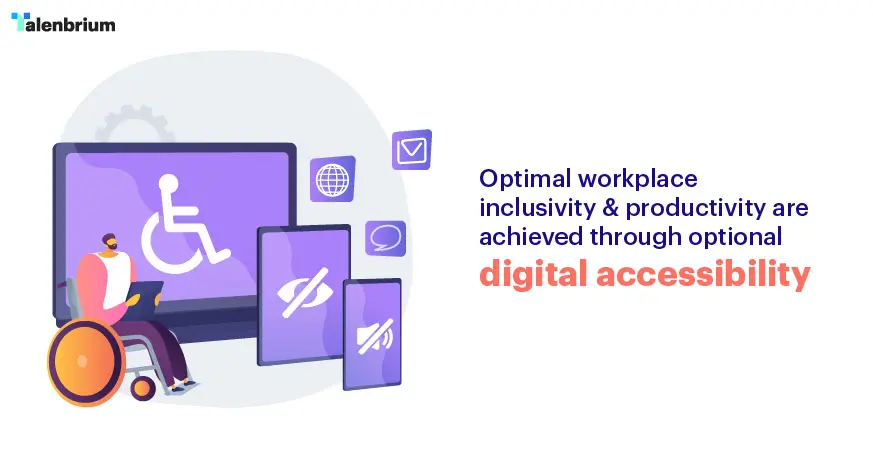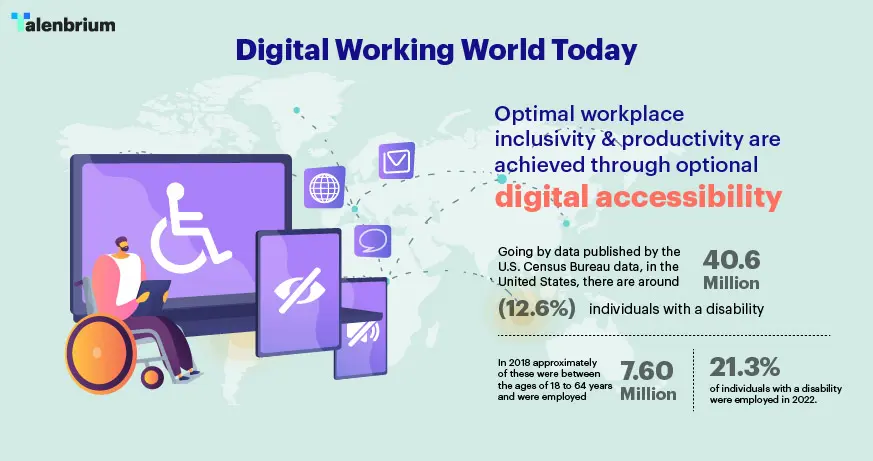Contact Us

Digital accessibility is based on four principles, which is better known by the acronym ‘POUR’. The expanded form stands for Perceivable, Operable, Understandable, and Robust.
The phrase ‘digital accessibility’ may not be something that a sizable majority of working individuals may be familiar with, but it is the practice of removing barriers to enable persons with disabilities to access digital services, including those provided to employees by companies and organizations. This can include providing access to digital tools, websites, audio support, and technologies, among others. Overall, it is the practice of ensuring digital products and services are available to all inclusively, regardless of physical or other differences or special needs. This concept is based on the Web Content Accessibility Guidelines (WCAG) established in May 1999 in the United States, and continues to gain importance as a means of inclusion, diversity, and transparency among employees, and serves to create harmonious work culture.
Digital accessibility is based on four principles, which is better known by the acronym ‘POUR’. The expanded form stands for Perceivable, Operable, Understandable, and Robust. Being simple enough and self-explanatory, these principles are playing a major role in organizations and companies across the globe. Digital accessibility at the workplace is also gaining importance as it ensures that no employee is excluded from accessing and being aware of important information and services made available to employees and stakeholders.
Design of digital products and material would need to vary within organizations and companies embracing the ‘digital accessibility at the workplace’ concept and needs to be viable and friendly for all consumers, should be accessible and interactable with, regardless of a person’s disability. For example, digital content would need to be designed in a way that is easy to use, has text clarity, and offers better navigation, which are features that benefit users of all abilities. For instance, the use of assistive or adaptive technology, such as closed captioning of video to enable hearing impaired individuals to read what is being said, and audiobooks to convert text to speech to assist visually impaired or partially sighted individuals to hear what is written.
An increasing number of companies are prioritizing digital accessibility in recruitment as this conveys commitment to diversity and inclusion, attracts a wider pool of candidates and indicates openness to include individuals with disabilities, reduces unconscious biases, and improves efficiency of recruitment process. Going by data published by the U.S. Census Bureau data, in the United States, there are around 40.6 million (12.6%) individuals with a disability. In 2018, approximately 7.6 million of these were between the ages of 18 to 64 years and were employed. This figure has risen over subsequent years, and 21.3% of individuals with a disability were employed in 2022, which was an incline from 19.1% in 2021. This also shows that the unemployment rates for individuals with a disability declined in 2022, which is considered a positive outcome.

The digital age has been having majorly positive outcomes on the job front, and previously individuals with a disability were faced with significant challenges securing employment of job opportunities. This however has been narrowed down owing to easy Internet connectivity and speed and availability and use of a variety of connected and smart devices to enable integration and communication, ranging from personal as well as professional purposes and applications.
According to data, 62% of adults with a disability currently own a desktop or laptop computer, and 72% own a smartphone. To put it into better perspective, percentage point comparison between individuals with and individuals without a disability, put it at a range of 16–20 respectively. This also highlights the number of potential or prospective job candidates that recruiters may be missing out on, and this number goes into the millions.
Currently, equal opportunity is being fielded more proactively and companies are engaging and deploying newer strategies to access and bring aboard the best talent in the market. With this in focus, companies and recruitment marketing professionals are having to revamp their recruiting and hiring strategies to ensure accessibility for all. Primary on the list of considerations is mindset, which is crucial as companies and recruiters need to develop or build processes that ensure inclusivity, and this approach needs to be an in-built part of the process, as opposed to being something of an afterthought or an adjunct in order to be effective.
Another key consideration is honesty and transparency, as there needs to be absolute clarity about these commitments and the associated or related requirements. This needs to be similar as processes deployed to include other marginalized segments of the workforce, and building in inclusivity regarding the disabled population needs to be imbibed or assimilated into company culture. Also, leadership buy-In is a component that is essential to secure commitment to this effort on the part of executive leadership and cross-functional teams and must be done during the initial stage itself. This is to ensure success of digital accessibility as it needs to be incorporated into the organizational landscape, and a certain level of cooperation from these players is necessary in order to desired outcomes. In addition, tools and resources are a crucial component to ensure proper streamlining and functionality. Some amount of research will be required to get hold of helpful resources in the area of integrating digital accessibility into the company’s recruitment marketing.
Currently, a number of recruitment firms offer an accessible workplace even before an individual submits their job application or merely fills in initial forms or ticks off various criteria. Establishing sound digital accessibility in the workplace, despite the vital importance of inclusivity and equal opportunity objectives, can be challenging initially, or until it becomes a top-of-mind criteria in organizations. This requires some measures as well as actionable best practices to be deployed to establish sound accessibility practices at the workplace.
Some of the widely shared challenges to individuals with a disability include accessibility in physical environments and on the Internet, social exclusion, absence of assistive technology, and barriers in healthcare and in the workplace. Other primary challenges for such an individuals seeking a job opportunity is inaccessible technology or presence of portals and platforms that do not support inclusivity or do not cover the diverse types of disabilities. These barriers can limit opportunities for people with disabilities to get hired or be able to excel in a position when hired. A vast number of participants in various surveys state that it is certainly unfair on all levels for such individuals to be unable to have the opportunity to perform their job duties all because of inability to access basic workplace tools. In today’s technologically advanced world and with all the rapid advancements and innovation, it is not surprising to see or hear about new developments and launches of solutions that are making the world a better place.
To start with, companies would be required to conduct regular accessibility audits and identify any existing accessibility barriers with regard to digital assets comprising websites, mobile apps, documents, portals, platforms, virtual tools, and others.
It is also critical to incorporate accessibility considerations at the very beginning of the design process to accommodate and plan for future additions or add-ons. Considering that individuals or users with certain limitations or disabilities would be using digital assets, websites or application pages should be checked to ensure these are navigable using keyboard and screen readers, and font size and contrast is appropriate, or options are easy to manage. This would also include ensuring availability of descriptive alternative text for images, graphics, and multimedia elements to enable screen readers to function when used by visually impaired individuals. A variety of digital assets and related applications and programs need to be regularly tested to identify and address accessibility issues. Some of the primary applications that need to be tested include assistive technologies, such as screen readers, voice recognition software, and screen magnifiers.
Another major area to be addressed is culture and values. Companies need to encourage a culture of accessibility within the organization, and this needs to be extended across levels of hierarchy and designation. In order to create a continuous trend, companies can also celebrate its success in this endeavor and continually emphasize the importance of inclusivity and the spirit of equality. Documentation of a company regarding accessibility policies and steps being taken or initiated in this regard should also be accessible to the public to drive transparency and favorable outcomes.
While this may seem like a benefit solely for an employee or potential candidate with a disability, it also serves the company well. Consider the benefits and advantages this approach can have for an organization. Apart from boosting employee morale, which is a win-win for employee and employer, it serves to attract like-minded job seekers, build brand awareness, create a positive and diverse workplace culture, and increase productivity.
Your email address will not be published. Required fields are marked *